
While Sony was able to generate some major buzz when it came to the forefront with its new flagship the Xperia Z, its mid-range line-up still needed a refresh. Although the Xperia P was a decent option from the company's Xperia NXT series, it didn't offer a large screen and had a low-capacity battery.
The Xperia SP was announced shortly after the Xperia Z as a mid-range alternative for people who didn't require a top of the line power-horse of a phone but wanted some novelty.
We find out if the new Xperia SP is a capable smartphone that offers a balance between form, features and performance.
Build/ Design
The Sony Xperia SP is built on the lines of its more powerful cousin, the Xperia Z, and looks like a rectangular slab from the front except for a translucent bar at the bottom, that glows up in different colours at certain actions/ events. Overall, it's a little boxy with corners that are subtly rounded. Another issue with the phone is its weight and thickness. At 155 grams the phone is anything but easy to lug around.
Perhaps one of the reasons for the phone's weight is a thick aluminium frame that surrounds the phone's body. We'll admit the phone does feel solid because of this.
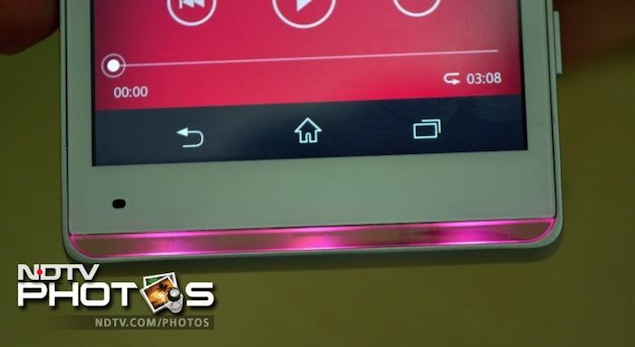 The phone comes in Black and White coloured variants and we had a White coloured one for our review unit.
The phone comes in Black and White coloured variants and we had a White coloured one for our review unit.
The front mainly features the 4.6-inch display, with proximity and light sensors above it along with a VGA camera lens. There's a microphone below the screen and the white bezel continues till it reaches a translucent bar that houses an LED light that lights up with different colours when you're playing music or browsing a gallery or receive a message or call.
On the right side you'll see a round aluminum power/screen-lock button towards and a volume rocker, also made of metal. The power button protrudes out and some might draw parallels with the crown of a watch, and we had seen it first in the Xperia Z. It's much smaller this time, though. The phone also adds a dedicated camera button towards the lower part at the same side. You'll also see screws on both the sides of the phone.
A Micro-USB port sits on the left side, while the 3.5mm headset jack is located on the top of the phone. The phone's back, unlike the Xperia Z, is rounded and there's a white removable plastic cover that hides the SIM card and microSD card slots. Even though the phone has a removable back cover, the battery is non-removable.
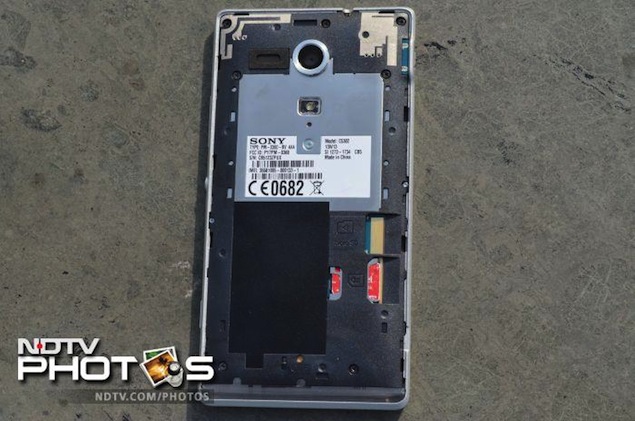 The 8-megapixel camera lens is towards the upper part of the back, with a small speaker outlet next to it and an LED flash and microphone below it. There's subtle Xperia branding in the middle.
The 8-megapixel camera lens is towards the upper part of the back, with a small speaker outlet next to it and an LED flash and microphone below it. There's subtle Xperia branding in the middle.
Display
The Xperia SP features a 4.6-inch screen with a resolution of 720x1280 pixels and the panel is made of tempered glass. The phone's screen is 0.3-inch less than that of the Xperia Z's screen and is not full-HD, which is expected since it's a mid-range phone. Sony also includes its BRAVIA Engine 2 to enhance images and videos.
While the phone renders images and text sharply, we observed that it appears to be washed out. The phone does offer settings for white balance and hue for the display, but we feel that blacks could have better.
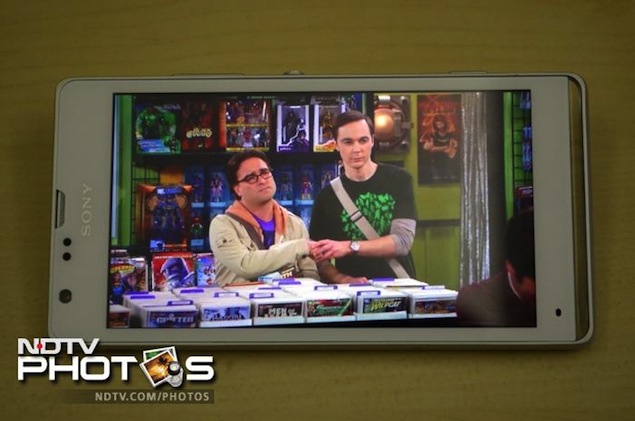 We also had minor gripes with the viewing angles offered by the phone's display. Under sun legibility was good when we used the phone with brightness set to the highest level, though the screen is reflective to some extent.
We also had minor gripes with the viewing angles offered by the phone's display. Under sun legibility was good when we used the phone with brightness set to the highest level, though the screen is reflective to some extent.
Software/ User Interface
The Sony Xperia SP ships with Android 4.1.2 Jelly Bean. It's not the most recent version, but that's consistent with many other new Android phones in the market. Sony has included its own UI skin on top of the software but it's not as deep as HTC's Sense UI, Samsung's TouchWiz or LG's Optimus UI, and is rather more close to the stock build. Sony says that the unified UI will bring the same user experience to tablets and phones, and include its media apps.
Just like the Xperia Z, the unlocking gesture of the lock screen resembles the motion of your finger through a set of window blinds and we've not seen this on any other phones till date. The lock screen also offers shortcuts to directly unlock and initiate the Walkman (for playing music) and the Camera app. However, unlike the LG Optimus G, you cannot customise the unlocking animation or change the app shortcuts. The phone offers on-screen buttons for navigation just like stock Android.
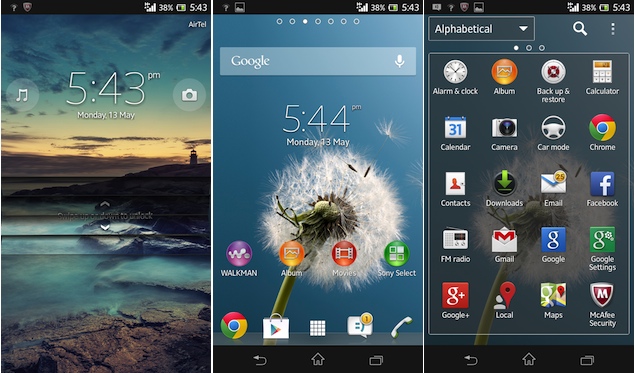 Sony includes its own Xperia keyboard with the phone that is different from the stock Android keyboard. We're not fans of this keyboard, and wish Sony could have included the option to switch to the stock keyboard.
Sony includes its own Xperia keyboard with the phone that is different from the stock Android keyboard. We're not fans of this keyboard, and wish Sony could have included the option to switch to the stock keyboard.
The Xperia SP also offers themes that change the colour scheme of the phone along with the home screen and lock screen wallpaper. You can choose to add up to seven home screens or even reduce the number to one. These can be populated with app shortcuts and widgets.
The notification tray adds toggles for sound, Bluetooth, Wi-Fi, mobile data and a shortcut to the settings menu. Sony also adds some of its own widgets for social networking service updates, power toggles and more.
Sony bundles its Walkman music player app, in addition to a gallery app that it calls 'Album'. In edition to displaying pictures on the phone, the app also allows users to connect to online services like Facebook and Picasa and view their online pictures. The app also includes a built-in photo editor.
For web browsing, the Sony Xperia SP bundles the Chrome browser, and removes the stock Android browser. Since Chrome doesn't support Adobe Flash player, the phone is not capable of playing Flash videos even if the Flash plugin is side-loaded.
The phone also includes additional apps including a Back up & restore app, McAfee Security, NeoReader for reading QR codes, a Notes app, TrackID (a Shazam like music recognition app), PlayNow, Smart Connect (which lets users set an event when an accessory is connected to the phone), Xperia Link (to share Internet connectivity with Sony devices), and Wisepilot (for navigation). There's also a Socialife app that lets you view updates from different social networks under one feed and Sony Select, Sony's own app store.
The Task Switcher button gives access to previously running and current apps, displaying a list on the right side. As with the stock app switcher, you can dismiss an app by sliding it. The switcher also brings access to Sony's small apps, which can run on top of other running apps, similar to LG's QSwipe apps and Samsung's pop-up play. Sony ships four of these small apps, namely Calculator, Timer, Notes and Voice Recorder but more small apps can be installed via the Play Store. We wish Sony had included a Video player and a web browser small app as well.
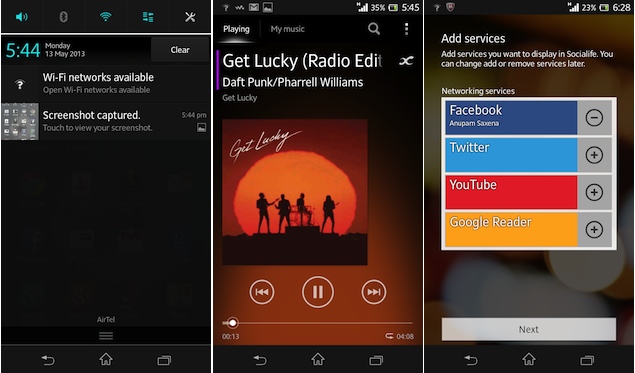
In addition to all of these, the phone brings standard Jelly Bean functionality. Overall, Sony has tried to keep the phone close to stock Android.
Camera
The Sony Xperia SP sports an 8-megapixel Exmor RS rear camera with auto focus and LED flash. The camera leaves out Burst mode, which is present in the Xperia Z.
The phone's camera app is feature rich and includes modes such as Superior auto, Normal, Video, Burst, Picture Effects, Sweep Panorama and different Scene selection.
The Superior auto mode doesn't let you customise granular settings barring that of Flash, Resolution, and Timer with the default resolution set to 3104x2328. The normal mode allows you to tinker with settings like Exposure value, White balance, ISO, and others. The camera also includes image and video stabilisation.
The pictures taken during daylight were good but we found the colours to be oversaturated. Photos taken indoors with sufficient amount of light, also looked decent barring the colour reproduction, which was a bit haywire. However, they were a bit grainy when light was not adequate. We observed that the Superior auto mode takes time to click since it automatically detects the photo mode, so there's a bit of a lag.
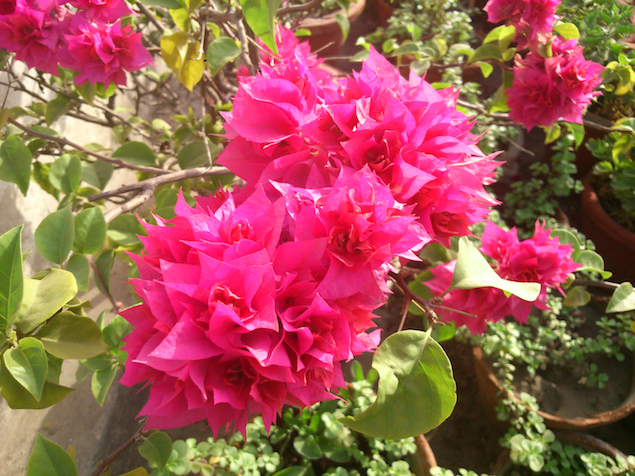 The camera disappoints while clicking low-light shots, which had a lot of noise.
The camera disappoints while clicking low-light shots, which had a lot of noise.
The Xperia SP can capture 1080p video but leaves out the HDR mode for video recording, which is seen in the Xperia Z.
The hardware camera key can be set to launch the camera app in video or still mode, or launch and capture pictures or videos.
In our tests, the phone took good videos and the stabilisation mode worked as promised. You can also take still shots of 1-megapixel resolution while recording video.
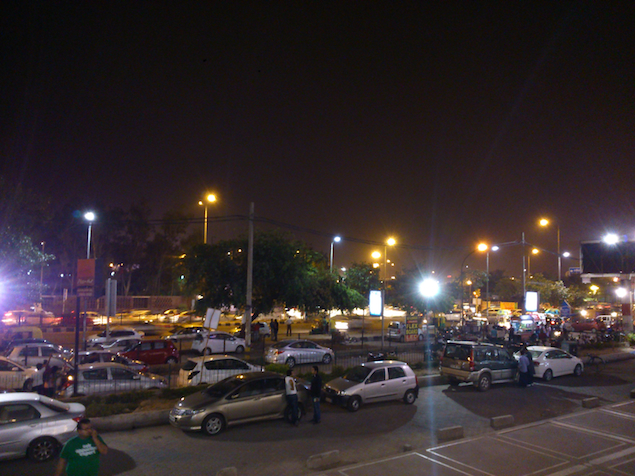 The Xperia SP features a VGA front-facing camera. The front camera is strictly functional and can be used for casual video chats.
The Xperia SP features a VGA front-facing camera. The front camera is strictly functional and can be used for casual video chats.
Performance/ Battery Life
The Xperia SP is powered by a 1.7GHz Qualcomm MSM8960Pro dual-core processor with 1GB RAM onboard, and an Adreno 320 chip for processing graphics. There is 8GB of internal storage, which is expandable by another 32GB via a microSD card. However, only 5.37GB of the 8GB is available to the user.
With Android 4.1 Jelly Bean, the overall experience of navigation through the interface was impressive, thanks largely to Project Butter. We did not experience any lag while launching apps, playing games, scrolling web pages or switching between apps.
We were able to play full-HD clips, and all formats including MOV and AVI were natively supported by the phone. The speaker on the phone delivers good quality sound at high volume levels but the loudness could have been better. The phone also supports ClearAudio+ that gives the sound more clarity while playing music. The phone also offers FM radio.
The call quality was good and the phone was able to latch on to the network in weak signal areas.
The Xperia SP comes with a giant 2370mAh battery, which is one of the highest capacity battery among its class and in our usage, it lasted us a day and a half. We charged the phone in the morning (at around 9am), and with medium to heavy usage, including about 2 hours of phone calls, two e-mail accounts with push notifications, playing some music (both on the phone and via internet radio), Twitter notifications and WhatsApp chats, we didn't need to charge the phone till noon, the next day. It's worth pointing out that we had turned off Wi-Fi and auto-brightness, and the phone was hooked to a 3G network with the screen brightness at the highest level throughout.
Altering these settings might help in running the phone for a longer duration, depending on your usage pattern.
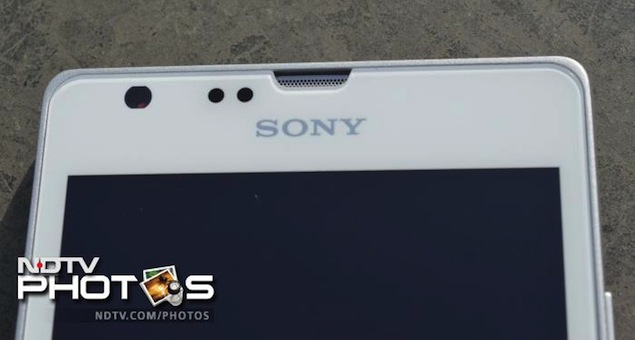 Sony also offers a STAMINA mode, which as per the company can improve the standby time by automatically shutting down battery-draining apps whenever the screen is off and starting them up again when the screen is back on.
Sony also offers a STAMINA mode, which as per the company can improve the standby time by automatically shutting down battery-draining apps whenever the screen is off and starting them up again when the screen is back on.
The phone comes with NFC, which can be used to beam files to other NFC enabled Android phones via Android Beam, and receive information from NFC tags. The phone also supports LTE (4G) connectivity, but the Indian LTE band of 2300MHz (Band 40) is not supported.
Verdict
The Sony Xperia SP is a good mid-range Android smartphone, especially if you want a phone that offers a good battery backup. Even performance wise, it does pretty well when it comes to doing day-to-day tasks and even playing medium to high end games, thanks to its Adreno 320 GPU.
However, at an asking price of around Rs.25,000, we feel that the phone has been priced a bit on the higher side as we were disappointed with its screen and the camera's low-light performance.
If you're in the market for a mid-range Android phone you could also look at the Samsung Galaxy S II Plus, LG Optimus L9 and the Samsung Grand (if you don't mind a phablet).
If you can pump up your budget by a few thousand rupees, you could also consider buying the Samsung Galaxy S III or the HTC One X+, which are now available at considerable discounts compared to their original launch prices.
The Xperia SP was announced shortly after the Xperia Z as a mid-range alternative for people who didn't require a top of the line power-horse of a phone but wanted some novelty.
We find out if the new Xperia SP is a capable smartphone that offers a balance between form, features and performance.
Build/ Design
The Sony Xperia SP is built on the lines of its more powerful cousin, the Xperia Z, and looks like a rectangular slab from the front except for a translucent bar at the bottom, that glows up in different colours at certain actions/ events. Overall, it's a little boxy with corners that are subtly rounded. Another issue with the phone is its weight and thickness. At 155 grams the phone is anything but easy to lug around.
Perhaps one of the reasons for the phone's weight is a thick aluminium frame that surrounds the phone's body. We'll admit the phone does feel solid because of this.
 The phone comes in Black and White coloured variants and we had a White coloured one for our review unit.
The phone comes in Black and White coloured variants and we had a White coloured one for our review unit. The front mainly features the 4.6-inch display, with proximity and light sensors above it along with a VGA camera lens. There's a microphone below the screen and the white bezel continues till it reaches a translucent bar that houses an LED light that lights up with different colours when you're playing music or browsing a gallery or receive a message or call.
On the right side you'll see a round aluminum power/screen-lock button towards and a volume rocker, also made of metal. The power button protrudes out and some might draw parallels with the crown of a watch, and we had seen it first in the Xperia Z. It's much smaller this time, though. The phone also adds a dedicated camera button towards the lower part at the same side. You'll also see screws on both the sides of the phone.
A Micro-USB port sits on the left side, while the 3.5mm headset jack is located on the top of the phone. The phone's back, unlike the Xperia Z, is rounded and there's a white removable plastic cover that hides the SIM card and microSD card slots. Even though the phone has a removable back cover, the battery is non-removable.
 The 8-megapixel camera lens is towards the upper part of the back, with a small speaker outlet next to it and an LED flash and microphone below it. There's subtle Xperia branding in the middle.
The 8-megapixel camera lens is towards the upper part of the back, with a small speaker outlet next to it and an LED flash and microphone below it. There's subtle Xperia branding in the middle.Display
The Xperia SP features a 4.6-inch screen with a resolution of 720x1280 pixels and the panel is made of tempered glass. The phone's screen is 0.3-inch less than that of the Xperia Z's screen and is not full-HD, which is expected since it's a mid-range phone. Sony also includes its BRAVIA Engine 2 to enhance images and videos.
While the phone renders images and text sharply, we observed that it appears to be washed out. The phone does offer settings for white balance and hue for the display, but we feel that blacks could have better.
 We also had minor gripes with the viewing angles offered by the phone's display. Under sun legibility was good when we used the phone with brightness set to the highest level, though the screen is reflective to some extent.
We also had minor gripes with the viewing angles offered by the phone's display. Under sun legibility was good when we used the phone with brightness set to the highest level, though the screen is reflective to some extent.Software/ User Interface
The Sony Xperia SP ships with Android 4.1.2 Jelly Bean. It's not the most recent version, but that's consistent with many other new Android phones in the market. Sony has included its own UI skin on top of the software but it's not as deep as HTC's Sense UI, Samsung's TouchWiz or LG's Optimus UI, and is rather more close to the stock build. Sony says that the unified UI will bring the same user experience to tablets and phones, and include its media apps.
Just like the Xperia Z, the unlocking gesture of the lock screen resembles the motion of your finger through a set of window blinds and we've not seen this on any other phones till date. The lock screen also offers shortcuts to directly unlock and initiate the Walkman (for playing music) and the Camera app. However, unlike the LG Optimus G, you cannot customise the unlocking animation or change the app shortcuts. The phone offers on-screen buttons for navigation just like stock Android.
 Sony includes its own Xperia keyboard with the phone that is different from the stock Android keyboard. We're not fans of this keyboard, and wish Sony could have included the option to switch to the stock keyboard.
Sony includes its own Xperia keyboard with the phone that is different from the stock Android keyboard. We're not fans of this keyboard, and wish Sony could have included the option to switch to the stock keyboard.The Xperia SP also offers themes that change the colour scheme of the phone along with the home screen and lock screen wallpaper. You can choose to add up to seven home screens or even reduce the number to one. These can be populated with app shortcuts and widgets.
The notification tray adds toggles for sound, Bluetooth, Wi-Fi, mobile data and a shortcut to the settings menu. Sony also adds some of its own widgets for social networking service updates, power toggles and more.
Sony bundles its Walkman music player app, in addition to a gallery app that it calls 'Album'. In edition to displaying pictures on the phone, the app also allows users to connect to online services like Facebook and Picasa and view their online pictures. The app also includes a built-in photo editor.
For web browsing, the Sony Xperia SP bundles the Chrome browser, and removes the stock Android browser. Since Chrome doesn't support Adobe Flash player, the phone is not capable of playing Flash videos even if the Flash plugin is side-loaded.
The phone also includes additional apps including a Back up & restore app, McAfee Security, NeoReader for reading QR codes, a Notes app, TrackID (a Shazam like music recognition app), PlayNow, Smart Connect (which lets users set an event when an accessory is connected to the phone), Xperia Link (to share Internet connectivity with Sony devices), and Wisepilot (for navigation). There's also a Socialife app that lets you view updates from different social networks under one feed and Sony Select, Sony's own app store.
The Task Switcher button gives access to previously running and current apps, displaying a list on the right side. As with the stock app switcher, you can dismiss an app by sliding it. The switcher also brings access to Sony's small apps, which can run on top of other running apps, similar to LG's QSwipe apps and Samsung's pop-up play. Sony ships four of these small apps, namely Calculator, Timer, Notes and Voice Recorder but more small apps can be installed via the Play Store. We wish Sony had included a Video player and a web browser small app as well.

In addition to all of these, the phone brings standard Jelly Bean functionality. Overall, Sony has tried to keep the phone close to stock Android.
Camera
The Sony Xperia SP sports an 8-megapixel Exmor RS rear camera with auto focus and LED flash. The camera leaves out Burst mode, which is present in the Xperia Z.
The phone's camera app is feature rich and includes modes such as Superior auto, Normal, Video, Burst, Picture Effects, Sweep Panorama and different Scene selection.
The Superior auto mode doesn't let you customise granular settings barring that of Flash, Resolution, and Timer with the default resolution set to 3104x2328. The normal mode allows you to tinker with settings like Exposure value, White balance, ISO, and others. The camera also includes image and video stabilisation.
The pictures taken during daylight were good but we found the colours to be oversaturated. Photos taken indoors with sufficient amount of light, also looked decent barring the colour reproduction, which was a bit haywire. However, they were a bit grainy when light was not adequate. We observed that the Superior auto mode takes time to click since it automatically detects the photo mode, so there's a bit of a lag.
 The camera disappoints while clicking low-light shots, which had a lot of noise.
The camera disappoints while clicking low-light shots, which had a lot of noise.The Xperia SP can capture 1080p video but leaves out the HDR mode for video recording, which is seen in the Xperia Z.
The hardware camera key can be set to launch the camera app in video or still mode, or launch and capture pictures or videos.
In our tests, the phone took good videos and the stabilisation mode worked as promised. You can also take still shots of 1-megapixel resolution while recording video.
 The Xperia SP features a VGA front-facing camera. The front camera is strictly functional and can be used for casual video chats.
The Xperia SP features a VGA front-facing camera. The front camera is strictly functional and can be used for casual video chats.Performance/ Battery Life
The Xperia SP is powered by a 1.7GHz Qualcomm MSM8960Pro dual-core processor with 1GB RAM onboard, and an Adreno 320 chip for processing graphics. There is 8GB of internal storage, which is expandable by another 32GB via a microSD card. However, only 5.37GB of the 8GB is available to the user.
With Android 4.1 Jelly Bean, the overall experience of navigation through the interface was impressive, thanks largely to Project Butter. We did not experience any lag while launching apps, playing games, scrolling web pages or switching between apps.
We were able to play full-HD clips, and all formats including MOV and AVI were natively supported by the phone. The speaker on the phone delivers good quality sound at high volume levels but the loudness could have been better. The phone also supports ClearAudio+ that gives the sound more clarity while playing music. The phone also offers FM radio.
The call quality was good and the phone was able to latch on to the network in weak signal areas.
The Xperia SP comes with a giant 2370mAh battery, which is one of the highest capacity battery among its class and in our usage, it lasted us a day and a half. We charged the phone in the morning (at around 9am), and with medium to heavy usage, including about 2 hours of phone calls, two e-mail accounts with push notifications, playing some music (both on the phone and via internet radio), Twitter notifications and WhatsApp chats, we didn't need to charge the phone till noon, the next day. It's worth pointing out that we had turned off Wi-Fi and auto-brightness, and the phone was hooked to a 3G network with the screen brightness at the highest level throughout.
Altering these settings might help in running the phone for a longer duration, depending on your usage pattern.
 Sony also offers a STAMINA mode, which as per the company can improve the standby time by automatically shutting down battery-draining apps whenever the screen is off and starting them up again when the screen is back on.
Sony also offers a STAMINA mode, which as per the company can improve the standby time by automatically shutting down battery-draining apps whenever the screen is off and starting them up again when the screen is back on.The phone comes with NFC, which can be used to beam files to other NFC enabled Android phones via Android Beam, and receive information from NFC tags. The phone also supports LTE (4G) connectivity, but the Indian LTE band of 2300MHz (Band 40) is not supported.
Verdict
The Sony Xperia SP is a good mid-range Android smartphone, especially if you want a phone that offers a good battery backup. Even performance wise, it does pretty well when it comes to doing day-to-day tasks and even playing medium to high end games, thanks to its Adreno 320 GPU.
However, at an asking price of around Rs.25,000, we feel that the phone has been priced a bit on the higher side as we were disappointed with its screen and the camera's low-light performance.
If you're in the market for a mid-range Android phone you could also look at the Samsung Galaxy S II Plus, LG Optimus L9 and the Samsung Grand (if you don't mind a phablet).
If you can pump up your budget by a few thousand rupees, you could also consider buying the Samsung Galaxy S III or the HTC One X+, which are now available at considerable discounts compared to their original launch prices.
Source : NDTV
Sony Xperia SP Full Specifications
| GENERAL | 2G Network | GSM 850 / 900 / 1800 / 1900 - all versions |
|---|---|---|
| 3G Network | HSDPA 850 / 900 / 2100 - C5303 | |
| HSDPA 850 / 900 / 1700 / 1900 / 2100 - C5302 HSDPA 850 / 900 / 1900 / 2100 - C5306 | ||
| 4G Network | LTE 800 / 850 / 900 / 1800 / 2100 / 2600 - C5303 | |
| LTE 850 / 1700 / 1900 / 2100 - C5306 | ||
| SIM | Micro-SIM | |
| Announced | 2013, March | |
| Status | Available. Released 2013, April |
| BODY | Dimensions | 130.6 x 67.1 x 10 mm (5.14 x 2.64 x 0.39 in) |
|---|---|---|
| Weight | 155 g (5.47 oz) |
| DISPLAY | Type | TFT capacitive touchscreen, 16M colors |
|---|---|---|
| Size | 720 x 1280 pixels, 4.6 inches (~319 ppi pixel density) | |
| Multitouch | Yes, up to 10 fingers | |
| Protection | Corning Gorilla Glass | |
| - Sony Mobile BRAVIA Engine 2 |
| SOUND | Alert types | Vibration; MP3 ringtones |
|---|---|---|
| Loudspeaker | Yes | |
| 3.5mm jack | Yes |
| MEMORY | Card slot | microSD, up to 32 GB |
|---|---|---|
| Internal | 8 GB (5.8 GB user available), 1 GB RAM |
| DATA | GPRS | Up to 86 kbps |
|---|---|---|
| EDGE | Up to 237 kbps | |
| Speed | HSDPA, 42 Mbps; HSUPA, 5.8 Mbps; LTE, Cat3, 50 Mbps UL, 100 Mbps DL | |
| WLAN | Wi-Fi 802.11 a/b/g/n, dual-band, Wi-Fi Direct, DLNA, Wi-Fi hotspot | |
| Bluetooth | Yes, v4.0 with A2DP | |
| NFC | Yes | |
| USB | Yes, microUSB v2.0 (MHL) |
| CAMERA | Primary | 8 MP, 3264 x 2448 pixels, autofocus, LED flash, check quality |
|---|---|---|
| Features | Geo-tagging, touch focus, face and smile detection, image stabilization, HDR, sweep panorama | |
| Video | Yes, 1080p@30fps, video stabilization, check quality | |
| Secondary | Yes, VGA |
| FEATURES | OS | Android OS, v4.1 (Jelly Bean) |
|---|---|---|
| Chipset | Qualcomm MSM8960T Snapdragon | |
| CPU | Dual-core 1.7 GHz Krait | |
| GPU | Adreno 320 | |
| Sensors | Accelerometer, gyro, proximity | |
| Messaging | SMS(threaded view), MMS, Email, Push Email, IM | |
| Browser | HTML5 | |
| Radio | Stereo FM radio with RDS | |
| GPS | Yes, with A-GPS support and GLONASS | |
| Java | Yes, via Java MIDP emulator | |
| Colors | Black, White, Red | |
| - SNS integration - TV-out (via MHL A/V link) - Active noise cancellation with dedicated mic - MP4/H.263/H.264/WMV player - MP3/eAAC+/WMA/WAV player - Document viewer - Photo viewer/editor - Voice memo/dial - Predictive text input |
| BATTERY | Li-Ion 2370 mAh battery | |
|---|---|---|
| Stand-by | Up to 635 h (2G) / Up to 734 h (3G) | |
| Talk time | Up to 10 h 25 min (2G) / Up to 19 h (3G) | |
| Music play | Up to 39 h |









